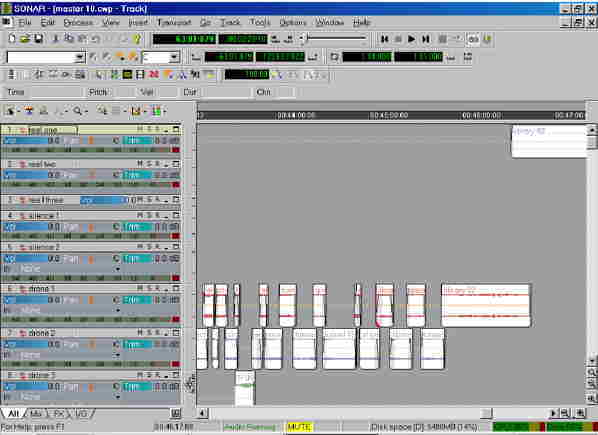|
For the recording parts of the project, there were two basic
set-ups, one powered and one portable. The powered set-up consisted of
two Oktava MK219 large diaphragm mics, an SPL goldmike preamp and a
TASCAM DA-20MkII DAT machine. The mobile solution used OKM binaural
mic's plugged into a Sharp minidisk.
The Oktava's are great microphones, and i'd recommend them
unreservedly if you're looking for an inexpensive large diaphragm mic.
I've used them in a number of situations, and they've always performed:
also the Dr Who styling of them is kinda cute. Here they were
configured for the most part as a stereo pair, using a T-bar on a
single mic stand.
The OKM's come similarly recommended: they look like a cheap
pair of walkman headies, but they're actually studio quality
condensers. They also come with their own preamp, which gives
substantially better results than the mic preamp built into a minidisk
recorder. It's a great set-up to take on a gig, cos it all fits into a
pocket, it's inconspicuous in use, but the recordings are good enough
to release, if it turns out the gig is a particularly auspicious one,
as gigs sometimes are.
|
|
Once we'd actually made the recordings, they were
transferred to hard disk via M-Audio sound cards and then mixed
together in Sonar:

The original plan was to use two tracks, 'reel one' and
'reel two' and cut between the two, but like everything else on this
project, it became more complicated than that, and we ended up with
eight tracks. Sonar was ever so easy to use, and the crossfades were no
problem. Because of the nature of the project, we didn't use much in
the way of effects - there's just enough compression on the main
outputs to bring out the detail, though there is a section of
'silences' which has a little extra compression on it, as it was a bit too
silent, especially on speakers...
Talking of which, the stereo recording techniques mean that
the finished thing sounds best on headphones, and we'd recommend that
you try it that way, if at all possible. Probably the most fun is to
walk around with a portable stereo on, cos you get an interesting
contradiction between the acoustic spaces your ears are telling you
you're in and the spaces your eyes are reporting, but maybe that's just
me.
|





